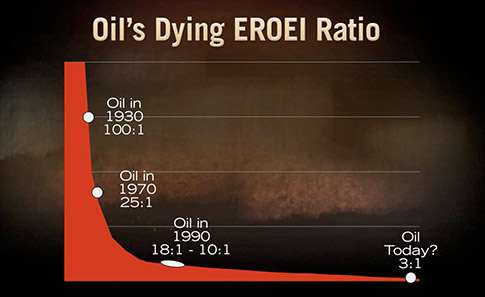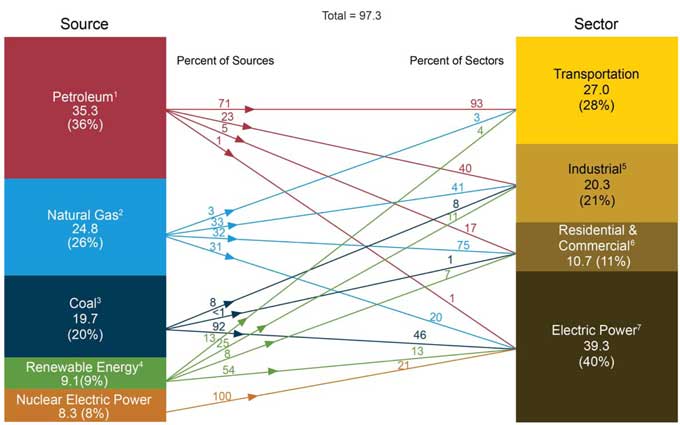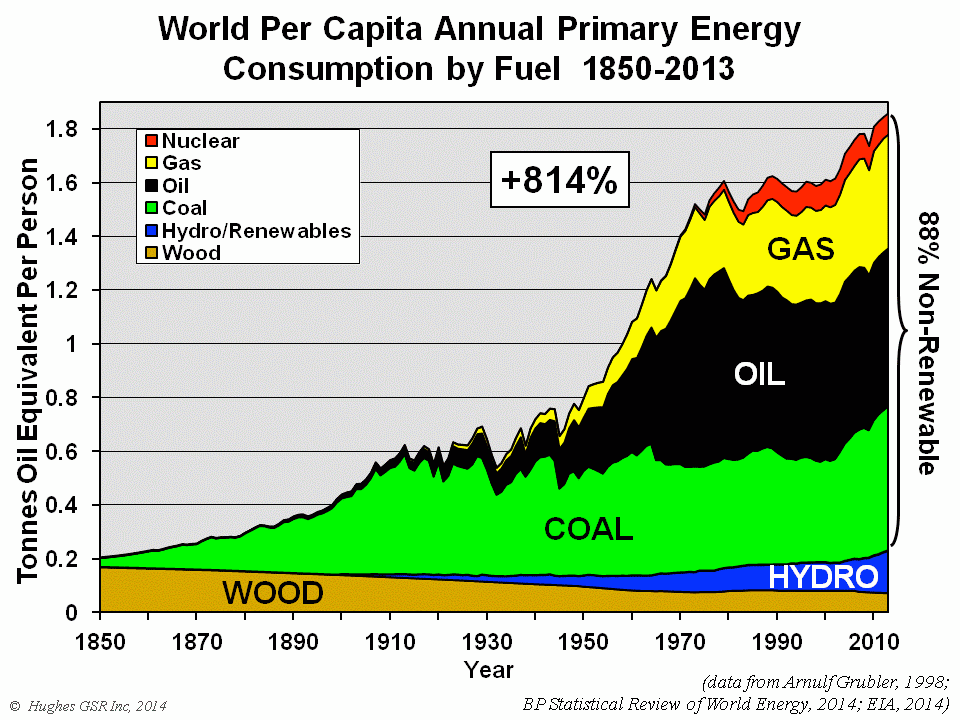In a very worthwhile recent essay on our post-carbon future, Richard Heinberg discusses the various aspects of our transition to a society, and specifically economy, that is not powered by carbon-based fuels. Often this discussion is approached from two opposing view points. On the one hand we have the belief that there is abundant renewable energy provided by sun and wind and that mankind will undoubtedly overcome any technological hurdle that keeps us from a sustainable future. On the other, there are plenty of doomsday scenarios on how our current growth driven consumer society is about to collapse in a world of finite resources (arguably there is also a third view that neither peak oil nor climate crisis are real and we can just continue the party as before, but we can safely dismiss this in my view). The correct approach might lie, as often, in the middle way and only a sober, fact based analysis will show us a meaningful course of action.
To distill his detailed essay, the most interesting points for me were as follows:
Usage of primary energy
We often analyze the use of renewables only in the context of electricity generation (wind, PV, hydro, etc.). However, only about 40% of all primary energy is consumed for power generation. The rest is required for transportation, heating, manufacturing, agriculture, etc. A complete strategy for a sustainable future will need to provide strategies to eliminate the carbon energy in the 60% as well. This means that above the need for renewable power generation we need to think about the use of energy in all other sectors. Radical efficiency and wise use of primary energy will be the hallmark of such strategies.
(source: EIA)
The intermittancy challenge
The effectiveness of renewable sources to replace carbon-based sources has to factor in the intermittancy of generation. Wind and solar are erratic and produce sometimes a lot, some not enough energy. Once renewable sources reach a certain percentage of the overall grid mix, further investments are required in storage capacity, grid upgrades for power distribution as well as to handle a more decentralized production of electricity. According to a recent study by Weissbach, renewable systems might not be able to provide a positive EROI if all the costs are factored in.
Embodied energy and distribution energy
Renewable energy sources cannot only be measured by their direct generation cost. While the lack of input materials such as coal, gas, etc. makes renewables by now cost efficient in their kWh prices of generation (leaving the complex topic of subsidies for all energy sources aside), we also have to account for the energy required to produce things like solar panels, to distribute and assemble them. This is all only possible with carbon energy today and it is unclear how a self-propelled replacement strategy could look (e.g. solar breeders, etc.). In any case, if accessible carbon-based energy will dramatically decline in the next decades, it must not be squandered but primarily be used to drive the transition to renewable energy. This must be a major focus of policy.
Energy density drives energy use
Carbon fuels, specifically oil, have an incredible energy density for weight or volume. It is an energy store created by nature over millions of years using plants, sun light, pressure and heat. Today's renewable adhoc conversion of sun (and the resulting wind) energy plus its storage cannot come close to this level of energy density. Certain energy uses, like aviation, are hard to imagine without such a high density. Global transportation of goods in a global trade economy becomes doubtful. We must look for opportunities to replace carbon energy with renewables where it is easy for us to do. We must consider more localized economies. We cannot waste the remaining energy on useless goods or low-value uses. Analysis has to focus on where we can live with a lower density and replace those uses first.
Additivity
Mankind has in the past switched energy sources from wood to coal to oil to nuclear. But those transitions have been additive in order to satisfy the rapidly increasing demand for energy to support our wealthy lifestyles and global population growth. The next century will pose the challenge not to add, but replace these sources with renewable ones.
(source: David Hughes)
The right questions
Using Google's RE<C project as an example, we need to review if we are asking the right questions of renewables. It seems very clear by now that they cannot in any form uphold the existing growth-based, resource-depleting consumer society model (which is independent of energy discussions an absurd model in a finite world). The more relevant questions center around how an economy and society will function given the natural constraints of a sustainable system and, equally important, how we most expediently transition to that state.
Overall, I believe Heinberg's essay rightly points us to not falling into the opposing camps of the Cornucopians or Doomers. We need to rationally work out what is realistically possible and how to get there. We need to focus on energy generation and energy use. We need to work out transition strategies for all sectors. Our work is cut out for us.
Sunday, January 25, 2015
Monday, January 12, 2015
Renewable electricity on a good trend in Germany
Despite the mostly bleak news on energy globally, the German 2014 energy data gives grounds for optimism. Renewables have delivered 27.3% of electricity in Germany, topping even lignite (brown coal) as a source. The continued rise compensates mostly for the phase out of nuclear energy, but it also starts to replace hard coal simply by price. The reduction in hard coal has also led to an overall reduction in CO2 emissions.
More importantly, whilst the economy grew in 2014 and electricity prices dropped, the amount of electricity consumed went down by 3.8%. This shows that the correlation of electricity consumption, CO2 emissions and economic growth can be decoupled by clean sources and efficient use.
Lastly, the report shows that the grid can be capable of handling the fluctuations of renewable energy production. In 2014, while more wind and solar energy was produced overall, less conventional power plants had to be activated to balance peak times. With more storage capacity becoming available, this can further improve.
There is a lot more to do for the "Energiewende", but some fundamental trends are beginning to emerge on price, emission and reliability of renewable electricity. This should serve as a blue print for other regions to transition their electricity system to become sustainable. After all, it is not a question of "if" you transition, but "how".
More importantly, whilst the economy grew in 2014 and electricity prices dropped, the amount of electricity consumed went down by 3.8%. This shows that the correlation of electricity consumption, CO2 emissions and economic growth can be decoupled by clean sources and efficient use.
Lastly, the report shows that the grid can be capable of handling the fluctuations of renewable energy production. In 2014, while more wind and solar energy was produced overall, less conventional power plants had to be activated to balance peak times. With more storage capacity becoming available, this can further improve.
There is a lot more to do for the "Energiewende", but some fundamental trends are beginning to emerge on price, emission and reliability of renewable electricity. This should serve as a blue print for other regions to transition their electricity system to become sustainable. After all, it is not a question of "if" you transition, but "how".
Friday, January 2, 2015
Why renewable EROI matters
However, there is more to this story. In a recent quarterly newsletter, GMO's Jeremy Grantham discusses the beginning of the end of the fossil fuel revolution (starting page 12 in the Q3-2014 issue). I am a big fan of Grantham's data driven and common sense review of market mechanisms. Despite the recent price drop due to short lived US fracking sources and OPEC response to it, the times of cheaply available oil are over. The debate about peak oil, the point at which maximum possible oil extraction is reached, and oil subsequent depletion, at which oil reserves are used up faster than new ones are discovered, seems to have been settled in recent years. It is mostly the point in time for the peak to occur that seems debatable, but even that is generally placed within a decade or so. I recommend a look at part one of the transition handbook or the Post Carbon Institute to get a deeper understanding of the details.
So why does this matter so much? Can't we just switch over to eternally affordable renewables if we need to? Here is where EROI (also often called EROEI) comes in. The "energy return on investment" is crucial to our current lifestyles. In the early oil days, an investment of $1 would have returned $100 worth of energy (an EROI of 100). In recent years, this has steadily declined as oil is much harder to come by. In some scenarios, we are reaching almost negligible ROI on oil extraction.

More so, if energy was once available at, say, $10, and the value it created was about $200 (a low boundary in Grantham's research), then our society benefited from an energy surplus worth $190 on each barrel extracted! It is this surplus that fueled our growth oriented, wealthy lifestyle. All sorts of convenient uses of oil were possible due to this surplus.
The second key element here is what we do with this value. If we use a barrel of oil as fuel to operate heavy machinery, one man can do the work of hundreds hence adding significantly to our level of prosperity. If, however, the same barrel is going to low value uses (e.g. throw away plastic wrappings, unnecessary transportation of goods, inefficient energy use, etc.), it does not add to our level of prosperity. One could argue that continued reduction in EROI will eliminate low level uses of energy sources.
Now, back to renewables. The question is not whether we can replace our conventional energy sources with renewable ones in a short enough time frame. This switch has to happen for climate reasons alone and will be one of the largest challenges mankind has faced so far. And, according to David MacKay's research "Sustainable energy - without the hot air" , a quiet improbable undertaking in itself.
But even if we pull it off, renewables as it stands have a radically different EROI than fossil fuels in their hayday. It takes quite some energy to produce solar panels, so their return is maybe 7:1 (outside of the interesting concept of "solar breeders"). Hydro is the strongest contender, but even the best estimates do not go over 40:1 and it comes with limited scalability of hydro locations. Wind energy might lie somewhere between that with 18:1. Given that our growth based economies fundamentally depend on high EROI and that the return for fossil fuels is not only dwindling but the resource itself is rapidly depleting, we have to seriously think about the implications for our global economic system and our consequently our daily life styles.
In summary, instead of just looking at how we can quickly increase our percentage of renewable energy sources as part of our overall usage, we need to aggressively become more efficient in all forms of energy use and eliminate low-value uses to preserve the crucial high-value uses that support our quality of living. It is very questionable to me if our current consumer societies can be sustained with quickly dwindling fossil resources. That party is simply over.
----------------------
Some reading material:
- Grantham's analysis on the end of fossil fuel revolution
- Prof. MacKay's "Sustainable energy - without the hot air"
- Post Carbon Institute's view on energy reality
Subscribe to:
Posts (Atom)





